|
www.ridrom.uclm.es |
Roman Law, |
INTERNATIONAL REVIEW OF ROMAN LAW
|
www.ridrom.uclm.es |
Roman Law, |
INTERNATIONAL REVIEW OF ROMAN LAW
|
APRIL 2018 |
GLOSSAE

GLOSSAE. European Journal of Legal
History, currently directed by Professor Masferrer, is the original
GLOSSAE.
Journal of European Legal History founded in 1988 by the Professor and
disciple
of Professor Rafael Gibert y Sánchez de la Vega, Antonio Pérez Martín,
with the
support of the European common Law institute, University of Murcia
(Spain).
The founding of the original GLOSSAE
was the answer to
the restlessness of
Professor Pérez, after the
incorporation of Spain in the European Community, to give a European
dimension
precisely to the History of Law. In this way, GLOSSAE emerged as a new
historical-juridical journal whose purpose was and continues to be, the
study
and scientific dissemination of European Law within the framework of
the ius
commune.
From its first 254 pages of that
first issue, to the more than 1000 of the last one published in
November 2017,
there are two stages that the history of this Journal has lived:
A first stage, from 1988 to 1996, in
which eight issues of great impact in the academic community were
published and
a second stage, after an interval of more than 15 years, fruit of
which, 6 are
the numbers that have already seen the light with a broader spectrum,
markedly
international, aimed at scholars of the Spanish, European,
Anglo-American legal
tradition, as well as scholars of other non-Western traditions.
In accordance with
this international dimension, we should
highlight the diverse nationality of those who are part of the
'Editorial
Board' and the 'International Advisory Board'.
Likewise, in line with this
extension of the thematic and geographical scope, the on-line
publication, free
and open of GLOSSAE, contributes even more to its dissemination and
internationalization, being able to be consulted by all those
interested in the
studies of the History of Law, from anywhere in the world.
INFORMATION OF INTEREST
Start:
1988
Editions:
14 (2017)
Frequency:
Annual
ISSN:
2255-2707
Editor:
Intituto de Estudios Sociales, Políticos y jurídicos
Country:
Spain
Webpage:
www.glosae.eu
|
APRIL 2016 |
VERGENTIS
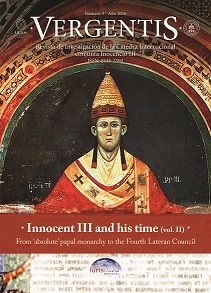
VERGENTIS
is a scientific Journal of the Innocent III International Chair of
Research for research in the History of law, Common law, Roman Law and
Canon
law; a Chair founded by the Pontifical Lateran University, through the Institutum Utruisque Iuris and the
Catholic University of Murcia.
Within the broad
educational and research project of the aforementioned Chair, the
Journal VERGENTIS has as main
purposes not only
get to be a space of reflection and multidisciplinary search but also
help in a
special way to communication between scholars and professionals of the
Law,
legal History, Roman law, Ius commune
and the Canon law.
Directed by the
professors Belda and Nacci of the Catholic University of Murcia and the
Pontificia Università Lateranense respectively, VERGENTIS
has, besides its 5 associate editors, 2 secretaries and 3
proofreaders, with a very large number of professors who are part of
their
Scientific Committee from different countries, universities and
different
disciplines, which gives a sample of the opportunity afforded us to
legal
experts from very different historical and legal specialties the
opening of a
dialogue deep in direct contact with the human experience and the
culture that
surrounds us.
This young bi-annual
Journal (December and June), which has the merit of appearing published
in
paper format and digital, is addressed to a public interested in
deepening
scientific, both a public eager to exchange views more extensive in the
world
of culture, law and history.
INFORMATION OF
INTEREST
Start: 2015
Editions: 3 (2016)
Frequency: Bi-annual
ISSN:
2445-2394
Editor: Universidad Católica San Antonio de
Murcia: Servicio de Publicaciones
Country: Spain
Webpage:
http://www.vergentis.ucam.edu/
|
APRIL 2016 |
RIVISTA DI DIRITTO ROMANO

It
was in 2001, practically at the turn of the 21st century, when the
first issue
of the Rivista di Diritto Romano. Periodico
di storia del dirittoromano di dirittiantichi e dellatradizione
romanística
medievale e moderna
came out. It was in this way that the immense need for a
Roman
Law magazine published online was met, whose wake was followed with its
own
stamp Diritto@Storia (2002) (See VIEW OF MAGAZINES- RIDROM 4/2010);
General
Magazine of Roman Law (2004) (See VIEW OF MAGAZINES- RIDROM 6/2011)
and, so
far, the International Magazine of Roman Law (2008) from which we
address our
readers.
There are many benefits indeed that
this tool can have regarding research in the field, starting with the
ability
to consider this Rivista, just as
its
introduction conceived, as a kind of electronic center capable of
making
available to everyone a general picture of the innumerable places all
over the
world that are interested, in one way or another, in the romanistic
discipline,
intermediate or comparative law. A platform which contains summaries of
juridic
and literary texts; links in which vocabulary, repertoires, library
catalogs,
as well as websites related to subjects of history, archaeology,
epigraphy, papyrology,
etc.
A magazine which, as an electronic instrument,
also offers the
possibility of not only updating, in real time, the calendar of
romanistic events,
congresses or conferences but also maintaining constant and fluid
contact with
other colleagues; additionally, it is a fundamental objective to make
publications that have been recently published available to the
scientific
community as well as reissues / reprints of older copies (the most
important of
which being the six volumes of the Basilic in the edition of the
Heimbach
brothers); indices of works and sources, facilitating the consultation
of
fundamental works which are difficult for young researchers and
universities more
recently created to find. A magazine in which even the possibility of
“Bacheta”
publishing works that are pending of publication is offered. A job
which is
truly commendable and shows great generosity on behalf of its creators.
All of that, just as we can see for
ourselves, with just a click, on behalf of users with a great deal of
work and
effort, on behalf of those who are part of the team of this visionary,
online
and open Rivista di Diritto Romano,
which is managed by Professor Zuccotti, from his desk in Turin, and
which is
made up by, as members of his Scientific Committee, professors Andreau,
Ankum, Sirk,
Torrent and Wacke.
A magazine, in short, just as was
expressed in its introduction, in which tension about a past which is
still
current is combined with its link as a cybernetic instrument, situating
it in a
present projected onto the future.
INFORMATION OF INTEREST
Start: 2001
Editions: 15
(2015)
Frequency: Annual
ISSN:
1720-3694
Editor: Edizioni
Universitarie di Lettere Economia Diritto (LED)
Country: Italy
Webpage:
http://www.ledonline.it/rivistadirittoromano/
|
APRIL 2015 |
REVISTA DE ESTUDIOS HISTÓRICO-JURÍDICOS
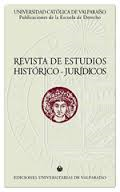
The Historic-Legal Studies Review (RHE), whose
first
issue appeared in 1975, belongs to the Pontifical Catholic University
Law
School in Valparaiso, one of the most prestigious and the third oldest
Law
Schools in Chile.
Primarily aimed at professors and research
professors
in historic-legal Sciences, not only professionals, but also those
training, it
includes a wide variety of subjects related to this field. Its main
goal is to
spread original and unpublished research articles in fields like Roman
Law, History
of Law (public and private), History of Canonical Law, European Law,
Spanish-American
Law, as well as History of Iberoamerican National Law, the impossible
to forget
Chilean Law, or the Legal Dogma and Legal Thought History.
The edition, available in printed as well as
on-line
and for free, allowing for wider circulation, facilitating access to
it, which
since the first issue, can be viewed on the website www.rehj.cl.
Under the direction as editor of professor
Guzmán, the
RHEJ boasts a large board of edition made up of professors from the
Pontifical
Catholic University of Valparaiso: professors Salinas and Merello, or the Chilean University:
professor Dougnac,
and with an expert Scientific Board in which the Italian professors
Grossi, Bellomo,
Schipani and Catalano; Argentinian
professors Tau Anzoategui or
Levaggi;
professor Wacke from the German University of Cologne; Spanish
professors
Sánchez Bella, Peláez y Fernández de Buján, or professor Bravo from
Chilean
University are a part.
This publication will turn 40 in 2016 and it is an excellent example of adaptation to the new times and use of new technologies, as it is not only accessible in a traditional format but is also available on-line, which helps the scientific community to go on progressing thanks to an easy and free access to research, thus eliminating barriers and being an open platform to the world.
INTERESTING FACTS
Start: 1976
Issues: 36 (2014)
Frequency of publication: Annual
ISS on-line: 0717-6260
ISS printed version: 0716-5455
Editor: Ediciones Universitarias de Valparaíso
Country: Chile
Website: http://www.rehj.cl
|
APRIL 2014 |
ESTUDIOS CLÁSICOS
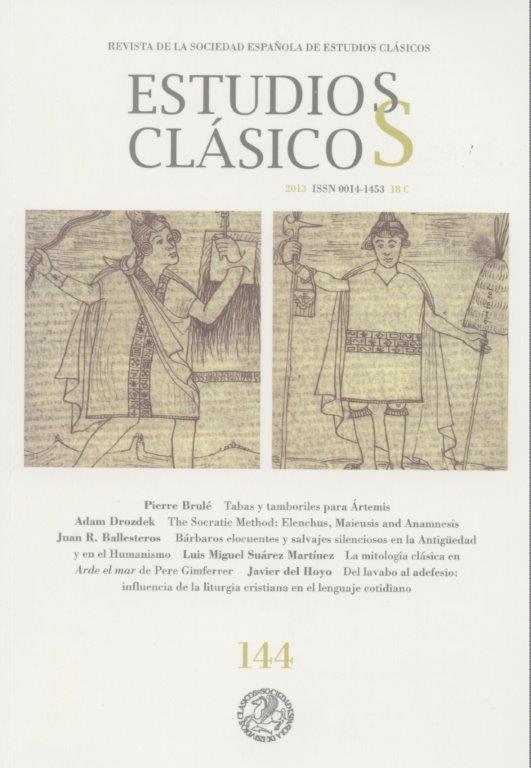
La Sociedad Española de Estudios Clásicos, SEEC, (the Spanish Society for Classical Studies) is one of the oldest and largest scientific partnerships and one of the most important associations of its kind in Europe. Currently chaired by Professor Siles, There are 23 delegations spread throughout the Spanish territory and it has around 5.000 members, some of whom are teachers of Latin and Greek for High School and University Education, researchers from a wide variety of subjects related to the classical field (Classical Philology, Ancient History, Philosophy, Arts, Archaeology, Laws…) and in general terms, people interested in the Roman and Greek period
It´s main objectives are not only the promotion of the knowledge of the Classical Ages as a way to understand our cultural roots but also the strengthening and role of academic subjects related the classical language and culture and its role in our educational system, the support of teachers in their task of teaching by offering them a representative authority as well as updated scientific and didactic information. Moreover, four-year plan meetings and congresses are organized under the support of this association.
Such conventions are considered as the most important Spanish scientific event related to Classical Studies. A wide variety of Spanish researchers within the field of Roman and Greek Literature and Linguistics, the Medieval Latin, the Latin Humanism and the classical tradition take part on them.
In recent years important sections such as Philosophy, Papyrology, Byzantin Empire Studies, Ancient History, Art, Classical Archaeology and Roman Law have also joined the project.
Since it was founded in 1950, the magazine “Classical Studies” is defined as “the SEEC broadcasting bulletin”. Tt´s published every six months thanks to all those contributions received and related to the Roman and Greek studies and its current survival. Such articles are interconnected to the classical culture, bibliographic and scientific updating and to the classical languages teaching, all of them divided in three different sections: SEEC´s Articles, Reviews and Activities. A new sector has been recently added: The Guest Researcher, that is to say: the publication of an article translated into Spanish from a foreign researcher related to new and outstanding topics related to the SEEC. As an example, the one published in the last edition of the magazine written by Professor Brulé (Rennes University) who published a research about the status of girls in the ancient Greece named “Knucklebones and tambourines to Artemis”.
INTERESTING FACTS
Start date: 1950
Editions: 144 (2013)
Periodicity: Biannual.
ISSN: 0014-1453
Publisher: Sociedad Española de Estudios Clásicos (SEEC).
Country: Spain.
Website: www. estudiosclasicos.org
|
APRIL 2013 |
JRS
THE JOURNAL OF ROMAN STUDIES
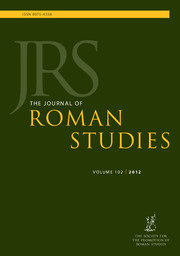
This prestigious publication, that has already completed its first centennial, obeys its existence to the Society for the promotion of Roman Studies, "the sister society" of Society for the Promotion of Hellenic Studies and its homonymous Journal of Hellenic Studies (JHS).
Society for the promotion of Roman Studies, on the other hand, it was founded on Friday, 3 June 1910 at the headquarters of Civil Service Commision in London, under the auspices of members of Hellenic Society, as the professors Gardner, Macmillan and Penoyre; the Professor Haverfiel of the University of Oxford; University of Cambridge, the Professor Laughs; of British Museum, as the professors Smith and Hill and, lastly, the Professor Hallam of Classical Association.
On its foundation in June 1910, the Society for the promotion of Roman Studies joined a group of classic organizations which, like it, survive to this day, such as Hellenic Society, British School at Athens, British School at Rome, Classical Association of Scotland (to which belongs its current Editor, the Professor Greg Woolf) and Classical Association. In fact, with that last a tense relationship took place, after the creation of JRS and not only because this new Journal had been able to enter in competition with to Classical Quarterly (CQ) and Classical Review, but also because own Classical Association, apparently, had been preparing a new journal of roman studies.
With the creation of JRS, Society for the promotion of Roman Studies was able to give execution two of its six initial objectives for which the Society was established: to promote the study of history, archaeology, literature and art of Italy and of the Roman Empire from the earliest times down to about AD 700, in furtherance of the above objects, but not further or otherwise and to publish a Journal whic contain original articles, reports of recent research and exploration in Roman lands, and notices or recent literature.
JRS is run by an Editorial Committe whose current Chairman is Dr Simon Esmonde; Publications Secretary is Dr. Lynn F. Pitts; Professor Catherine Steel is Review Editor and from 2014 on, she will succeed to the current Editor, Professor Gregory D. Woolf who, as he has commented us, has very much enjoyed his tenure as Editor and felt privileged to steward the Journal for a short time.
Together with those already mentioned Editor, Professor Woolf and Review Editor, Professor Steel, JRS has an Editorial Board formed by the Professors Borg, Edwards; Gibson; Gildenhard; Humfress; Kelly; Prag and Thonemann whose work has contributed to that this noted Journal can see the light every month of November and contributions coming from all Europe and America of the North can be included.
From 2010, JRS is published by Cambridge University Press and it’s possible to see the chart of contents of the papers published from 1996-2001, in http://www.romansociety.org/publications/journals/journal-of-roman-studies/back-issues.html.
On the other hand, from the year 2002 -2012, the summaries of the published papers can be consulted, in http://www.romansociety.org/publications/journals/journal-of-roman-studies/content-and-abstracts.html.
The Journal of Roman Studies continues being considered as the premier UK journal in its wide field of knowledge covering the publication of articles and peer-reviewed papers on Roman History from its beginnings until A.D. 700) and Latin literature, art and archaeology. Works that contribute, all of them, not only to have a wide vision and a better understanding of the Roman world, but rather they also foment the later discussion of so varied topics as the Roman democracy, the magnitude of the Roman economy, the demographic consequences of the slavery in Rome, Roman religion and a long one etc.. Topics which can interest specialists, students and general public, from all over the world.
INTERESTING FACTS
Birth: 1911
Numbers: 102 (2012)
Frecuency: Annual
ISSN: 0075-4358
Publisher: Cambridge University Press
Country: United Kingdom.
Web: http// www. journals.cambridge.org/action/displayJournal?jid=JRS.
|
APRIL 2012 |
INDEX
QUADERNI CAMERTI DI STUDI ROMANISTICI, INTERNATIONAL SURVEY OR ROMAN LAW
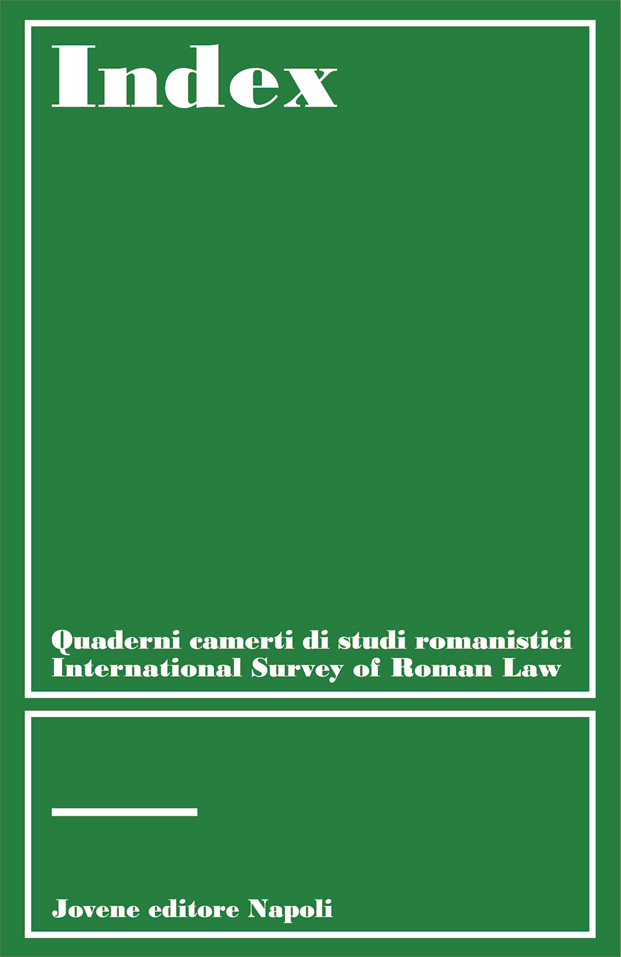
Camerino. January 30, 1969: Council of Faculty of Law. Dean, Pious Ciprotti; Secretary, Pietro Perlingieri. Day order: “Innovazioni negli Annali della Facoltà". Dean communicates to the members of the Council that the Professor Luigi Labruna has planned to carry out as appendix of Annali, a review of Roman Law divided in two sections: 1) Review; 2) Summary of the scientific production of Roman Law of those countries more difficult to obtain news.
A few months later, in october, the Council of Faculty decides that, given the great success of the Professor's proposal -because the scientific importance of the initiative has taken him to have collaborators of more than twenty countries of Europe and of outside of Europe-. what will have been an appendix to Annali of the Faculty, pass to be an autonomous publication directed by the Professor Labruna whose definitive title will be even specified and always with the Professor's expressed commitment of maintaining such an address and the continuity of this publication, still when he had to leave the University of Camerino.
This way, in the year 1970, under the auspices of the Faculty of Law of Camerino and of their School of improvement in civil right, the review was published with the title: "Index: Quaderni camerti gave studi romanistici. International Survey of Roman Law."
The title and the presentation, as innovative as classic at the same time that "pulitissima", they were suggested by Atanasio Mozzillo, one of the first pupils of Guarino that ended up being a great journalist and writer of modern history. In that moment, he was managing the editorial ESI to which Index was initially linked until starting from 1986 (XIV), when it passed editorial Jovene. On the other hand, the bilingual denomination, elect and present from their first volumen, it was advised by the professor of International Law in Camerino, Giorgio Gaja, with the possibility of a coedición agreement and international distribution with the Dutch editorial Oceana that, finally, it was not carried out. Anyway, such a denomination was in agreement with the same purpose with the one that Index was conceived.
Guarino, as all knows master of Labruna -Casimiro Sofo was made call in his original rubric "Sesta pagina” of Index -, when this first volumen was published, he expressed in Labeo, for him directed, a strange scepticism in connection with the duration and rhythm of the publication, at the same time that he favored an extensive and nurtured existence, such as come happening throughout these years, sign that the writing table has always been flooded of material to publish and that fruitful they continue being the relationships, such and like it was the desire of Guarino.
Purpose of Labruna, in the beginnings of the years 70 of S. XX, was to be founded in "the small, dynamics and very old University of Camerino" Index for, in that way, as him it has transmitted us, to renew bonds for broken time and to overcome the ideological skillful barriers and historiography, besides the politicians, existent, propitiating a deep plot of relationships with the athenaeums, institutions of high culture and scientist of all country.
Index was born this way: as fruit of those years in those that the scientific fervor, intellectual and cultural it was remarkable; the same years in those that the investigation and the teaching of the roman disciplines had "maybe entered still in a crisis non resolved" today, like in the year 1972 the Professor Capogrossi recognized- founder together with Labruna and Catalano of Gruppo di ricerca sulla diffusione del diritto romano of which Index ended up being organ starting from the edition of its third volúmen - and that forty years later, that problem continues without being solved.
Index, in words of the Professor Mercogliano, has never imitated other models, still being valuable, neither it is already a copy of reviews consolidated. Index what has sought, as own Labruna expresses us, it is to level the one on the way to the university internationalization in the environment of the science of the world Antiquity, before in the shade or completely unknown, to diffuse new methodologies and historiography tendencies, as well as to offer a limitless horizon of roman production literary .
This way, as the Professor Masi Doria indicates us, we can say that the genetic sign of Index consists in that still being an Italian and roman review, however it is projected to the reciprocal knowledge, it is an international bridge toward difficultly accessible or excluded realities, as well as an extension and everything with the purpose of context the phenomenon of the Roman Law from the historical, political and economic point of view.
Those near four hundred pages of their first volumen and the eight hundred of the last of those published, next to the thousands of pages that are of their XXXIX volumes, group in the diverse summaries that Index contains. To this respect, in the moment in the one that we are, facilitates the investigation work a lot that, thanks to NNTT, from the Volume I, published in 1970, to the Volume XXXI, corresponding with the year 2003, these summaries can be consulted in the address of internet: http://www.dptromano.unina.it/rivistaindex/sfondo.htm#Articles
On the other hand, those corresponding with the Volume published in the 2007, XXXV, to the summary of the year 2011, XXXIX, they can be consulted in http://dialnet.unirioja.es/servlet/revista?codigo=8476 for that that only the summaries of the years 2004-2006, at the moment, they are not in the net.
As closing of our humble homage to Index in our View of Reviews, serve the contents of the Editorial and of the Exordium, carried out respectively by Labruna in the first volumen of Index, and picked up for the professors Masi Doria and Mercogliano in the homage volume to their thirty years of existence. We believe that still today, forty two years after their publication, they continue serving us as reflection and of reason to continue working in our investigations and to continue given in the best way possible to our teaching, having as backdrop and that this makes headway us in the future:
"In a particular moment for the teaching and the investigation of the Roman Law disciplines and stiller in their teaching in the University. A time of crisis of methods and contents. of structures and university conceptions, but also of appearing tumultuous, and even positive of an important comparison with social and cultural new realities, Index offers the occasion for a reciprocal better knowledge among those that are dedicated to the study and the teaching of the Roman Law, whichever it is the political, cultural and juridical atmosphere in which they work".
INTERESTING FACTS
Birth: 1970.
Numbers: 39 (2011).
Frequency: Annual.
ISSN: 0392-2391
Publisher: Jovene Editore.
Country: Italia.
Web: http://www.dptromano.unina.it/rivistaindex/
|
OCTOBER 2011 |
REVUE INTERNATIONALE DES DROITS DE L'ANTIQUITÉ
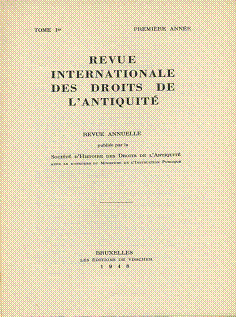
It was in the course of the hard winter of 1941-1942, during the German occupation, as explains the Professor De Visscher in the Preface of the first number of the Revue, when some jurists and Belgian historians founded in Brussels, in their opinion, a modest Société d’Étude des Drotis del’Antiquité -today known as Société internationale 'Fernand de Visscher' pour l'Histoire des Droits de l'Antiquité (SIHDA)- that, in spite of the many difficulties and deep concerns of the time, it could end up meeting in a regular way, giving place to a "belle activité" in the breast of this group.
The very ingrained desire of its founders to endow Société of an essentially international character made that, in an immediate way to the liberation of the Belgian territory, with the appointment and incorporation of foreign members to the group, it was carried out a first international session, in the year 1945, to the one that two years later a second - Brussels from the 24 to September 28 1947 -, in which an international numerous and brilliant participation was gotten.
Inside of this second encounter they decided to grant to these meetings a yearly character and also the birth of Revue International des Droits de l’Antiquitè (RIDA). Such and like it was conceived by their members, a simple summary of the papers presented in the congresses had not responded fully to the purpose of Société of to create and to develop the contacts, as well as the one of propitiating the permanent collaboration among scientific and erudite of all the countries.
This was the philosophy of their founders, F. De Visccher and of J. Pirenne, and for this reason their work continues today under the direction of the Professors H. Jones, J-H. Michel and J.-fr. Gerkens, on the other hand, also, organizer of LXV Congress that SIHDA has taken place, at the end of last month of September, in the University of Liège, around the general topic of "L'obligation dans them l'Antiquité droits, of the source à l'exécution" and in the one that, again, reality has been made, such and like it pursued De Visccher: «une collaboration des spécialistes de toutes les branches de l’histoire antique s’avère aujourd’hui aussi nécessaire qu’une collaboration internationale».
The field study that Revue is about embracing is at the present time, the same as it was it more than half century ago, immense and always attentive to the discovery of new documents and of new civilizations.
With a Chart of matters that includes studies on the Greek Law, Old and East Law and the Roman Law, the content is supervised by a Scientific Council divided in: Greek Law, represented by J. Mélèz-Modrzejewski, and in Roman Law, of which are part the professors H. Ankum, C. Cascione, E. Chevreau, R. Feenstra, C. Masi Doria, P. Pichonnaz, D. Pugsley, OR. Stanojevic and F. Sturm.
Administered by G. Hanard and with the secretary of A. Ruelle, RIDA, thanks to the collaboration of Fondation Universitaire of Belgique is, besides in format paper, accessible for internet, free pay, from the beginning of its Third Series, this is, from the Volume XLIV (1997), until the Volume LVI (2009).
Thanks to the legacy that their founders give us: not to neglect, like it pointed De Visscher to the end from their Preface to the first number of the Revue, the customs and the juridical conceptions of none of the towns that gravitated around the two poles of the old world, this is, Rome and Greece, in the first decade of the XXI century, still continue this commitment in each one of the pages of this noted Revue and every year, in each one of the international congresses organized by the Société Internationale 'Fernand de Visscher' pour l'Histoire des Droits de l'Antiquité.
INTERESTING FACTS
Birth: 1948.
Numbers: LVIII (2011).
Frecuency: Annual.
ISSN: 0556-7939.
Publisher: Office International des Périodiques.
Country: Belgium.
Web: http// www2.ulg.ac.be/vinitor/rida/
|
APRIL 2011 |
REVISTA GENERAL DE DERECHO ROMANO


The General Review of Roman Law (RGDR) is one of the four scientific reviews about Roman Law exclusively on electronic support that exist in the net, to day of today, together with Diritto@Storia, the italian also, Rivista de Diritto romano, and RIDROM.
RGDR is included in the collection of publications with complete text created by PORTALDERECHO S.A., company promoter of an ambitious portal that spread legal information. Through its web www.iustel.com, made by and for jurists, it has transformed into the encounter point for all the members of the juridical world: from students of Law until the most noted jurists, so much at professional level as academic.
Inside this collection of publications we meet with General Reviews that, in their different disciplines, they pick up the most novel and outstanding legal doctrine. The first of these General Reviews in being published, were that of Administrative Law (RGDA), at 2002 and the last in incorporating, Public Compared Law (RGDPC), at 2007. To half on the way, in January of the year 2004 - months before the General Review of Criminal Law (DP), the only two General Reviews published for the first time, the mentioned year -, saw the light the first number of RGDR, in that moment, only scientific Review of Roman Law in our country.
Directed by the Professor of Roman Law of the University Autónoma of Madrid, D. Antonio Fernández de Buján and under the Subbureau of D. Juan Miguel Alburquerque, Professor of Roman Law of the University of Córdoba, has the Review a large number of Council such Rectors as the Editorial Council, composed by 15 Professors of Roman Law, from 5 nationalities and that it gathers to an outstanding number of the big Teacher of the discipline[1]. On the other hand, the Council of external Appraisers, in turn, it is divided in the Body of Professors -more than fiftieth - and the Body of Regular - more or less, thirty -.
Also, RGDR has a number of Collaborators, as well as the Profra. Dra. Dña. Raquel Escutia of the Autonomous University of Madrid, in quality of Secretary, the Professor of Roman Law of the University of Córdoba, Prof. Dr. D. Salvador Ruíz Pino, as Vicesecretario and, lastly, Dña. Laura Pastor Marcos, as the person in charge by IUSTEL of the Coordination and the Edition of RGDR.
Directed especially to the specialists of the Roman Law, jurists of positive law and practical operators of the law, as well as to historians, philologists and philosophers, RGDR has welcomed from its birth, like one of its high-priority objectives, the contributions that are carried out in the classic mark of the scientific autonomy and university student of the studies about Roman Law as regards institutions, sources or methodology.
Among the sections that, previous subscription, we can consult: “Estudios"; "Varios: 1. Notas.Conferencias; 2. Recensiones"; "Revistas y sumarios"; "Bibliografía"; "Vínculos and other data of interest", all them elaborated had qualified professors of Roman Law and professionals of the law, national and foreigners.
It would suit to make reference to the published numbers and their marked international character: They have been published 15 numbers that gather a total of 314 papers, so far 61 notes, 142 recensiones, 12 necrological and 4 reports, what transforms among the most extensive of its kind. The scientific collaborations have been published for more than a hundred of specialists, of a dozen of nationalities[2], what proves their openly international character.
In the spirit of continuing advanced to the rhythm of the demands of our legal science and our society,as recognize the professors Fernández de Buján and Alburquerque, through this mean of communication and immediate information, of easy access and enormous diffusion possibilities, it is possible to transmit as much the scientific knowledge as the intellectual creation and everything it, with more advantages for the users regarding the traditional support in paper, when allowing an interactividad in the emission and reception, as well as a technical easiness of search and documentation file.
INTERESTING FACTS
Birth: 2004
Numbers: 15 (2010)
Frecuency: Six-monthly
ISSN: 1697-3046
Publisher: PORTALDERECHO, S.A.
Country: Spain
Web: http// www.iustel.com
[1] They are: Amarelli, F. (Catedrático de Derecho Romano. U. Nápoles. Italia); Amelotti, M. (Catedrático de Derecho Romano. U. Génova. Italia); Catalano, P. (Catedrático de Derecho Romano. U. Roma. Italia); Corbino, S. (Catedrático de Derecho Romano. U. Catania); García Garrido, MJ. (Catedrático de Derecho Romano. UNED. Madrid); Guzmán Brito, A. (Catedrático de Derecho Romano. U. Valparaíso. Chile); Knütel, R. (Catedrático de Derecho Romano.U. Bonn. Alemania); Labruna, L. (Catedrático de Derecho Romano. U. Nápoles); Metro, A. (Catedrático de Derecho Romano.U. Messina. Italia); Ortega, A. (Catedrático de Derecho Romano. U. Málaga); Rainer, M. (Catedrático de Derecho Romano. U. Salzburg. Austria); Schiavone, A. (Catedrático de Derecho Romano. U. Florencia); Schipani, S., (Catedrático de Derecho Romano. U. La Sapienza, Roma); Vacca, L. (Catedrática de Derecho Romano. U Roma III); Wolf, JG. (Catedrático de Derecho Romano.U. Friburgo de Brisgovia. Alemania)
[2] Spain, Italy, Germany, Russia, Cuba, Chile, Argentina, Poland, Colombia, Hungary, Mexico, Brazil.
|
OCTOBER 2010 |
STUDIA
ET DOCUMENTA HISTORIAE ET IURIS
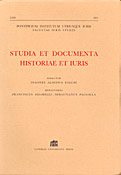
To speak of the history of one of the most prestigious italian Reviews of Roman Law, we should go back in the time at 1880. It is in this year when it begins its activity, as Accademia di Conferenze Storico-Giuridiche ‘s decision, the Review Studi e Documenti di Storia del Diritto among whose illustrious collaborators were the professors De Rossi and Alibrandi. Twenty-five volumes saw the light, but their publication concluded in 1904.
So the birth of Studia et Documenta Historiae Iuris owes to the Professor's proposal Albertario who promotes the emergence of this new one, in 1935, on the base of the previous Review born in 1880 and denominated "Primera serie”. In this way was as Prof. Albertario, “un organizzatore di energia e temperamento davvero senza pari”, -according to the recently marked words for Prof. Amarelli, with reason of the 75 anniversary of the Review- decides to make revive that old publication.
After Prof. Albertario other famous professors have managed the Review, like Prof. Riccobono, Prof. Larraona – who was elevated for John XXIII to the cardinal position-, Prof. Lombardi and currently Prof. Falchi.
The SDHI is defined for the Lateran University Press as the official organ and expression of the Civil Law Faculty, as well as the qualified contribution that offers the University Lateranense to the Scientific International Community, the same as it happens to the Reviews of the Philosophy Faculty, Theology, Canonical Right and John Paul II ‘s Papal Institute.
The Pontifical Lateran University inaugurated officially the Lateran University Press at 2001, with the purpose of continuing “l'intenso impegno editoriale come espressione della sua attività accademica nelle principali discipline storiche, filosofiche, teologiche, giuridiche e in generale nelle scienze umane, nella dottrina sociale e nelle scienze della famiglia.L'attenzione ai contenuti, la fedeltà alla tradizione, il rigore scientifico, la metodologia multidisciplinare, sono le principali caratteristiche che da sempre contraddistinguono e caratterizzano la Pontificia Università Lateranense nell'ambito della comunità accademica internazionale”.
In words of our dear Prof. Amarelli - collaborator of the Review with Lombardi, from 1970, and only redactor, from 1994, “(...) dagli anni Trenta del secolo scorso, e fino ai nostri giorni, la Rivista diventa la tribuna dalla quale, di volta in volta, si affacceranno tutti, quasi tutti, i grandi protagonisti della ricerca romanistica”.
It is in this context, in the one that year after year this credited and Italian distinguished publication contains original studies, notes, critical reviews, epigraphy reviews and legal papirologhy of so much of famous teachers, as of studious youths that are in charge of the law of the Antiquity and, in particular, of the Roman Law.
So, we wait and we want, adding us at once to the marked words commemorative of the 75 anniversary of SDHI for Prof. Falchi, that SDHI continues surrendering a service to the progress of our legal culture.
INTERESTING FACTS
Birth: 1935
Numbers: 76 (2010)
Frecuency: annual
ISSN: 1026-9169
Publisher: Lateran University Press.
Country: Italia
Web: http// www.e-lup.com
|
APRIL 2010 |
DIRITTO
E STORIA

For the first time in our View of Reviews an electronic review appears because Diritto@Storia. Rivista Internazionale di Scienze Giuridiche e Tradizione Romana is one of the four reviews of Roman Law in only electronic support in the net, together with the Italian review Rivista di Diritto Romano and the spanish reviews Revista General del Derecho Romano (RGDR) y la RIDROM.
From "Anno I -2002. Quaderno n. 1" until the actual "Anno VIII -2009. Quaderno n. 8. Nuova Serie", the, in that time, "Redattore", current "Direttore responsabile" is the dear Professor Sini.
Surrounded of an Executive Committee - formed by the professors of Roman Law of the Law Faculty of the University of Sassari (whose recently elected dean is Prof. Sini), the Profa. Cimma, the professors Comenale Pinto and Lobranno, as well as for partners of theFaculty of Sassari of the specialties of History of the Right, Constitutional and Mercantile, the professors Mastino, Pinna and Serra, respectively -, a Editorial Committee to which the professors of the Law Faculty belong and of the Department of juridical sciences of the University of Sassari, as well as of a series of professors that they work as foreign correspondents, as Prof. Biliarsky of Sofía, Profa. Britto of Pelotas, Prof. Guodong of Xiamen or Profa. Osaba of Bilbao and with the coordination of the works of Executive Secretary on the part of Profa. Rinolfi, Prof. Sini and the electronic review of Roman Law that he runs, make possible, as if of a virtual community it was, the exchange of knowledge, of information, the link with other bonds and it makes possible, number after number, through their very diverse sections (Memorie, Roman Tradizione, Contributi, D & Innovazione; Notice & Rassegne; Monografie; Cronache; Notizie; In Memoriam; Autori; Links; Search) that the production more current romanística arrives, thanks to internet, to all the places of the world, in question of seconds.
The current format appeared for the first time in "Anno IV. 2005. Quaderno n.4", being begun to add, from that moment also, the appellative of Nuova Serie.
In Diritto@Storia, besides those already mentioned sections that have left enlarging in the course of the different numbers (for example, the section In Memoriam appeared in "Anno II -2003. Quaderno 2", being devoted to Prof. De Martino. To the Professors Bona and Fuenteseca are devoted in the last number) they exist, like part of the Magazine, in the own cover, three links: IUS ANTIQUUM, Archivio Storico Giuridico and SEMINARIO DE DIRITTO ROMANO.
Of great interest for the quantity, variety and quality of the works in this review published, Diritto@Storia is a clear exponent of the new times that we live and of the useful thing that they can end up being NN TT to make arrive to all the corners of the world and user's type, our studies.
INTERESTING FACTS
Birth: 2002
Numbers: 8
Frecuency: annual
ISSN: 1825-0300
Publisher: Dipartimento di Scienze Giuridiche. Facoltà di Giurisprudenza - Università di Sassari
Country: Italia
Web: http: //www. dirittoestoria.it
|
OCTOBER 2009 |
ANUARIO DE HISTORIA DEL DERECHO ESPAÑOL
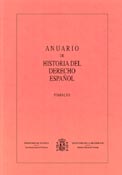
The first number of the Anuario came out to the street in the month of May of 1924. In their first volume, whose first pages were occupied by the article of Ramos Loscertales "The Iberian devotio", it was spoken of giving space to relating "works to the history of the Spanish Law, understanding each other this in their extensive sense and embracing then, from the most remote to the most recent stages in our juridical evolution”. It appeared published yearly and divided in four parts: the one dedicated to articles on topics of History of the Spanish, Spanish American and Muslim Law, another for the publication of outstanding documents for the History of Law, a third of bibliography and, finally, a section "Varia" in the one that news were included it has more than enough national or international congresses and any event of relevance as regards History of Law. Their director was Laureano Díez Canseco, professor of History of Law in Madrid and the team editor formed it José María Ots Padequí, professor in the University of Seville; Galo Sánchez, professor of History of Law in the University of Barcelona and José María Ramos Loscertales, professor of History of Spain in the University of Salamanca. The writing secretary was Claudio Sánchez Albornoz, direct continuator of Hinojosa's work.
From that first number, the magazine has been published year after year, until our days, except for Civil War parenthesis (year 1935, vol. XII). Renewed the publication in 1941 (vol. XIII), it begins to welcome to the romanists, highlighting the assiduous collaboration of Álvaro d'Ors, what transforms to the Anuario into a fundamental magazine for the specialists of the Roman Law.
At the present time, the Anuario counts in its to have with LXXVII volumes, the last published in January of 2007 and scarcely one year ago (November 10 of 2008), the then Secretary of Justice, Mariano Fernández Bermejo, named as new Director from the Anuario to Benjamin González Alonso, professor of History of Law of the University of Salamanca.
INTERESTING FACTS
Birth: 1924
Numbers: 77
Frecuency: annual
Publisher: Ministerio de Justicia, Centro de Publicaciones. Boletín Oficial del Estado
Country: Spain
Web: http: //www.mju.es/; http://www.boe.es
|
APRIL 2009 |
RITORNO AL DIRITTO
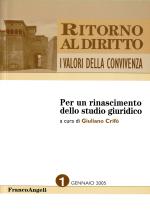
Sometimes a publication deserves to be read only by the title; in this particular case, the reading does not frustrate. “Ritorno al diritto. I valori della convivenza” is not a Law Review, but a Legal Science Review; it sets off a philosophical position about what the Law is; and that, apart from we are agree o not with it, comes to put back in discussion ideas like the not immutability of Law, the Law serving to the citizen –and not in the opposite way-, or Power and Society.
A manifiesto titled like the analysed publication and signed by 27 jurists from different fields was the origin of the Review. Like every manifiesto, it contains a bill of principles (8) that goes around three ideas: 1) if our society is not today an homogeneus but heterogeneus society, the legal science can not point towards one static type of human being, 2) the responsibility of the jurists in the innovation of the fundamental concepts of the legal science, 3) the overcoming of the norm towards legal assessments of de facto situations that get in consideration the plurality existing interests.
In consequence, it is about to elaborate the coexistence principles which can arrive us to an equity result, to the equilibrium between the human aspects involved in the juridical assessment in order to gain the best historical coexistence possible; so, the glance at Roman Law is inevitable like Law´s use example that the signers jurists suggest.
On this way, the Review was funded in 2005 by Giuliano Crifò and Federico Spantigati, with a cross-disciplinary character, like many say today. It is not attached to any concrete speciality, because its speciality is Law with capital letters, the legal science we refered to before. In most numbers, jurists from different fields write about monographic matters, like “Legality or Ilegality. The two faces of pluralism” (Fasc. 5, 2007), “Law and Literature” (Fasc.4, 2006), or the monographic that the last published number dedicates to some of the most eminence personalities of the Italian legal science from the last century ((F. Vassalli, E. Betti, S. Satta, R. Orestano, F. Benvenuti, A. Baratta, S. Romano, A. Giuliani, G. Capograssi, P. Fedele) (Fasc.7, 2008).
Each year contains two numbers and the Review is been published until 2008. Both paper and electronic edition by download from the editors´ web.
INTERESTING FACTS
Birth: The initial date corresponds with 2005 although the manifiesto in the basis of the new publication appears one year before.
Numbers: 7 published numbers, two by year waiting the 2008 second fascicule.
Frecuency: Biannual.
Publisher: Franco Angeli.
Country: Italia.
Web: http://www.francoangeli.it/
|
OCTOBER 2008 |
SEMINARIOS COMPLUTENSES DE DERECHO ROMANO
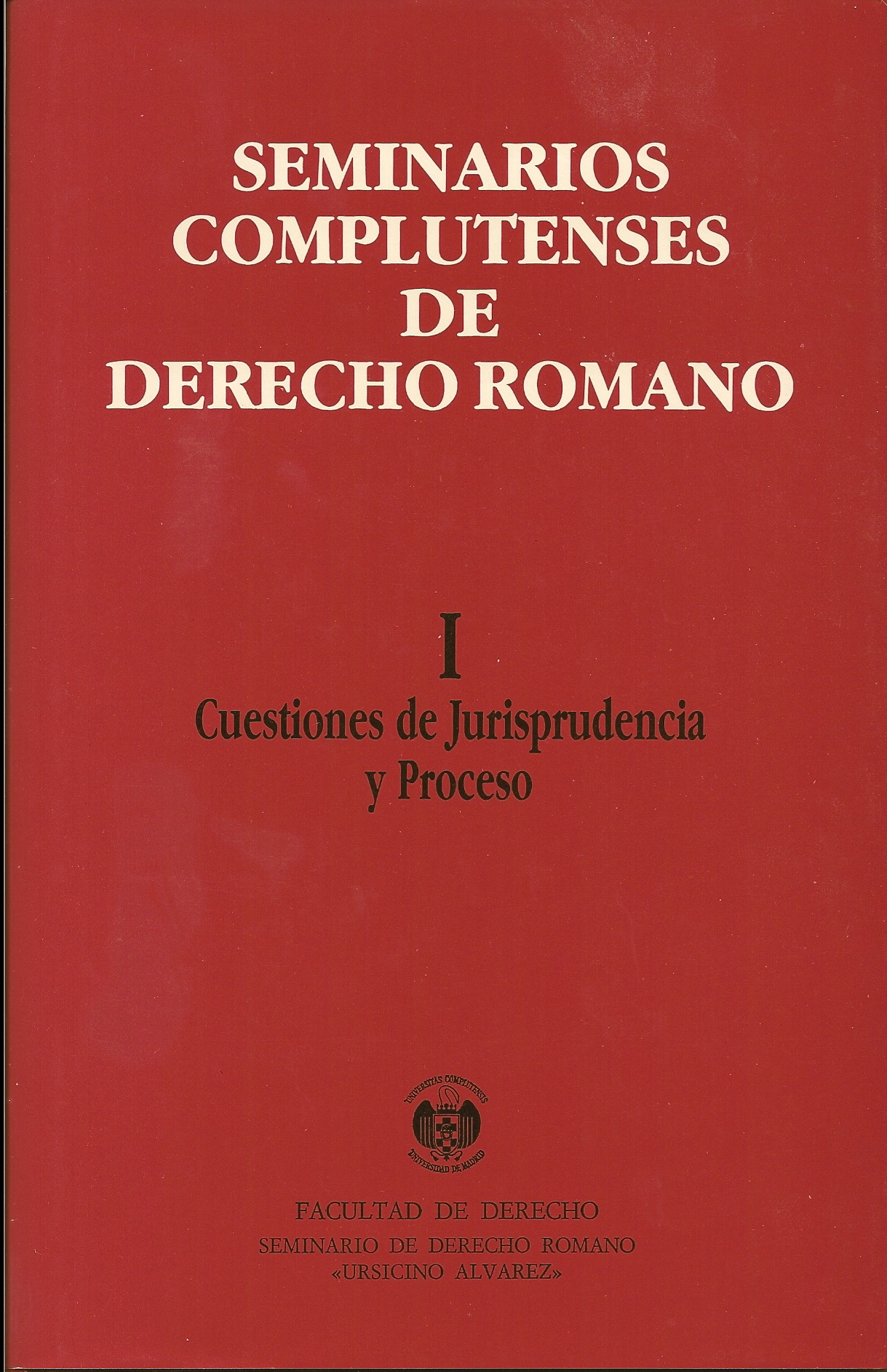
In 1990, the first number of the Seminarios Complutenses de Derecho Romano was published. The work born with the vocation to be the Seminars´ Acts which, in the occasion of the professor Arnaldo Biscardi´s investiture as doctor honoris causa, began at the Universidad Complutense de Madrid, in the academic year of 1988-1989. The Seminarios and the publication were both coordinated by the professor Javier Paricio.
From number XV and on, corresponding to year 2003, the publication´s title changes and, joined to the historical “Seminarios complutenses de Derecho Romano”, is added the subtitle “Revista complutense de Derecho Romano y tradición romanística”, changing again in the next year, 2004 nº XVI, having, definitely, the title “Seminarios complutenses de Derecho Romano: Revista internacional de Derecho Romano y tradición romanística”.
Nevertheless, the publication´s structure remains the spirit which was born: to be the effect from its cause, that is, the shape on paper of the scientific meetings celebrated. So, the 19th published numbers untill today are usually composed by a single corpus of doctrinal articles –in different number- introduced, sometimes, by short presentations or notes in memoriam – or including, cause obvious reasons, the laudatio and master class from the professor Arnaldo Biscardi´s investiture act, as doctor honoris causa in the first number-. In few several numbers, the articles belong to a common subject, which is the volume´s title, like number 1: “Jurisprudence and Prosecution´s Problems”, or number XV “Constitutional´s past and present problems”, or number XVIII, as special number, in memoriam of professor Ursicino Álvarez in occasion of the XXth anniversary of his death.
Accordingly the review doesn´t offer more sections than just dedicated to the research, except what it has been said about the notes and introductions.
In the academic year of 2008-2009, recently began, the “Seminarios” celebrate their 20th anniversary. From the beginning and on, the publication has been the reflection of the greats iusromanists participation, carrying out the quality purpose that aimed it in the first years. So, from RIDROM, which today births, we want that our first “view of review” is to one of the senior review in Spanish language.
INTERESTING FACTS:
- Birth: The first number corresponds to 1989, when the firsts “Seminarios” were celebrated, although the publication is in 1990.
- Numbers: 19 published numbers in 18th volumes (numbers IX and X corresponding to 1997 and 1998 are published in the same volume). Special number, XVIII, published in 2005, in occasion of the XX anniversary professor Ursicino Álvarez´s death. Last published number: XIX, corresponding to 2006.
Frequency: Yearly.
- ISSN: 1135-7673.
- Publisher: Fundación Seminario de Derecho Romano “Ursicino Álvarez”, Facultad de Derecho, Universidad Complutense de Madrid
- Country: Spain.
- Web: http://www.derecho-romano.org/seminarios.asp
Home/Information/Summaries/News/View of reviews/Links/Español
![]()